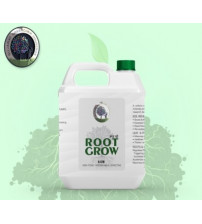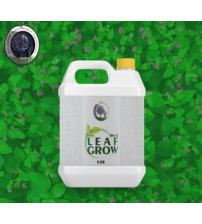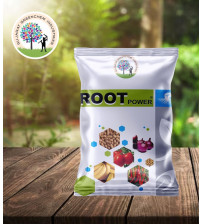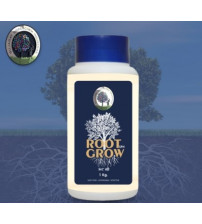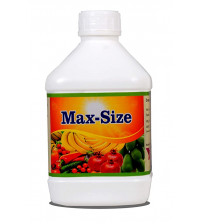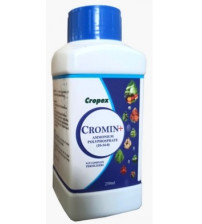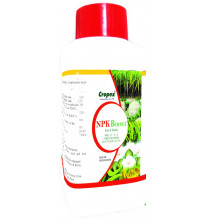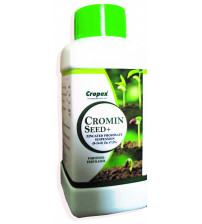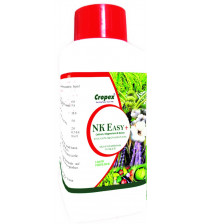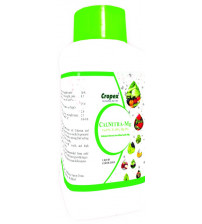Shopping Cart
0 item(s) - Rs 0.00Vrundavan PHOS (P.R.O.M.) 50kg
Brand: Raghavendra Fertilisers
Categories: Certified Organic Products, Organic Fertilizer,
Availability: In Stock
Cash on delivery Availability: NO
Phosphate Rich Organic Manure
Important
Minimum Order Quantity (State wise):
Gujarat, Maharastra & Karnataka = 100 Bags
&
Rest of India = 320 Bags.
(Order below Min. Order Qty. will not be delivered Free)
Product description:
Phosphate Rich Organic Manure could be a Direct replacement to Chemical Phosphate Fertilizers.
Application: 1 bag instead of 1 bag of DAP or 1 bag instead of 2 bags of Single Super Phosphate
ROLE OF PHOSPHOROUS:
- Symbol: P
- Available to Plant as Ortho Phosphate Ion (HPO4 and H2PO4)
- In photosynthesis and respiration Phosphorus plays major role in energy storage
- “Building Block” of plant
- Important element of RNA-DNA of plant cells
- Important element of ADP and ATP molecules of plant cell
- ADP and ATP molecules transfer energy for biochemical processes
- Seeds have the highest concentration of Phosphorous in a mature plant
- Phosphorus is required in large quantity in young cells, such as shoots and root tips, where metabolism is high and cell division is fast
- Phosphorous aids the root development, flower initiation, seed and fruit development
- Maintains balanced intake of Nitrogen and Potash
- Phosphorus is involved in formation of oils, sugar, starch etc.
- Yield deciding factor
- Di-ammonium Phosphate (D.A.P.)
- Single Super Phosphate (S.S.P.)
- Fixation means non-availability of given Phosphate
- Our soils contain salts like:
- Calcium
- Aluminum
- Iron
- Manganese
- These salts unite with Phosphate and become insoluble in water
- This insoluble phosphate is immovable and is not available to plants Organic matters in the soil is very less this adds to increasing fixation
- Fixation Percentage in Chemical Fertilizers: 60 -85%
- In soils with less than 6 pH and more than 7 pH more fixation
- High fixation in soils with clay contents
- Very high fixation in soil with low organic matter
- Micronutrients such as zinc, magnesium and boron are kept away from the plant
- Productivity is slowly going down
- The fertility of the soil is decreasing
- Because Phosphorus is needed in large quantity during the early stage of the cell division, the initial overall symptom is slow, weak growth and less germination
- Dark to blue, green coloration of older leaves of the plant. Under severe deficiency purpling of leaves and stem may appear
- Deficiency of Phosphorous can cause delayed maturity and poor seed and fruit development
- Low yield
Solutions to overcome the Phosphate Fixation and practical difficulties:
- Use of F.Y.M. or Green Manure or Maximum Organic matter:
- Good quality of F.Y.M. or Compost is not easily available
- Farmers are reluctant use organic matter
- The cost goes very high
VRUNDAVAN PHOS: COULD BE A COST EFFECTIVE ALTERNATIVE TO CHEMICAL PHOSPHATE FERTILIZERS
- Phosphate Rich Organic Manure
- Also known as Phosphocompost
It is a source of Phosphorous in neutral and alkaline soils
- It involves the incorporation of rock Phosphate ensuring the composting of organic matter
- During composting, a lot of organic acids and Humic substances are produced which results in increases microbial activity
- This increased microbial activity brings about the solublization and accounts for 75 % to 90 % Phosphorous solubalized.
- It contains Organic Carbon up to 10 %, so it can be Soil Rejuvenator
- Phosphate source for P.R.O.M. production is indigenous Rock Phosphate. Rock phosphate contains Silica in large proportion along with Phosphate. Silica is proving to be an important element for all crops.
Technical Action:
- Multiple molecules are converted into Mono Calcium Phosphate form by the action of our cultures
- Phosphorus from mono calcium phosphate is released
- Phosphate which is already in the unavailable form in the soil is also slowly released and gets converted into Phospho-Humate complex
- Microbial activity of the soil is steadily enhanced
- About 30% Phosphorus, 4 to 6% Silica and 4 to 6% Calcium is made available immediately and remaining as and when required
- Phosphate is yield deciding factor and phosphate is made available to plant
- About 15 to 30% yield increase
- Plant become strong, healthy, free from pest and disease
- Stimulates plant to uptake Ca and Si from soil
- Provides Micronutrients like Zn, Mg and Cu
- Rich with Micronutrient Fe
- Enhanced microbial activity so Soil become live and porous
- Water holding capacity of soil increases
- pH of soil becomes neutral
- Profuse root development
- Germination of seeds is triggered
- More tillers
- Stems become strong
- Optimum Girth of stem
- More number of leaves
- Extra vegetative growth is avoided
Vrundavan KROM 50kg
Rs 600.00
Min. Quantity: 100
Vrundavan KROM 50kg Organic Manure Important Minimum Order Quantity (State wise): Gujarat, Mahar.....
Vrundavan PHOS (P.R.O.M.) 50kg
Rs 750.00
Min. Quantity: 100
Vrundavan PHOS (P.R.O.M.) 50kg Phosphate Rich Organic Manure Important Minimum Order Quantity (St.....
Fost - Humic Acid 65% 500ml
Rs 250.00
Fost - Humic Acid 65% 500ml (Rootex) Organic Manure / Growth Promoter Click here to see Organic Ce.....
Fost - Humic Acid 65% 5 Litre
Rs 1,600.00
Fost - Humic Acid 65% 5 Litre (Rootex) Organic Manure / Growth Promoter Click here to see Organic .....
Immuno 1 Litre
Rs 550.00
Immuno 1 Litre Organic Fertilizer & Flower Stimulator Click here to see Organic Certificates o.....
Immuno 500 ml
Rs 300.00
Immuno 500 ml Organic Fertilizer & Flower Stimulator Click here to see Organic Certificates of.....
Immuno 5 Litre
Rs 2,000.00
Immuno 5 Litre Organic Fertilizer & Flower Stimulator Click here to see Organic Certificates o.....
ProVigor 500 ml
Rs 1,159.00
Min. Quantity: 20
ProVigor 500 ml Seaweed Extract-Fulvic Acid-Amino Acid Mix Bio fertilizer 500 ml bottle packing.....
ProVigor 1 liter
Rs 2,099.00
Min. Quantity: 10
ProVigor 1 liter Seaweed Extract-Fulvic Acid-Amino Acid Mix Bio fertilizer 1 liter bottle packi.....
Powercap - Pack of 5 Capsules
Rs 499.00
Powercap - Pack of 5 Capsules Description: Plant growth promoting Rhizobacteria (PGPR) are free li.....
Powercap - Pack of 10 Capsules
Rs 919.00
Powercap - Pack of 10 Capsules Description: Plant growth promoting Rhizobacteria (PGPR) are free l.....
NPK Cap - Pack of 5 Capsules
Rs 1,189.00
NPK Cap - Pack of 5 Capsules Description: Nitrogen phosphorus and potassium can justly be consider.....
NPK Cap - Pack of 10 Capsules
Rs 2,299.00
NPK Cap - Pack of 10 Capsules Description: Nitrogen phosphorus and potassium can justly be conside.....
Humaur - Bio-Organic Foliar Spray 250 ml
Rs 135.00
Min. Quantity: 40
Humaur - Bio-Organic Foliar Spray 250 ml Description: Humaur is beat for overall development of pl.....
Humaur - Bio-Organic Foliar Spray 500 ml
Rs 269.00
Min. Quantity: 20
Humaur - Bio-Organic Foliar Spray 500 ml Description: Humaur is beat for overall development of pl.....
Humaur - Bio-Organic Foliar Spray 1 Litre
Rs 545.00
Min. Quantity: 5
Humaur - Bio-Organic Foliar Spray 1 Litre Description: Humaur is beat for overall development of p.....
Humaur - Bio-Organic Foliar Spray 5 Litre
Rs 2,629.00
Humaur - Bio-Organic Foliar Spray 5 Litre Description: Humaur is beat for overall development of p.....
Singham - Amino Acid 250 grams
Rs 329.00
Singham - Amino Acid 250 grams Description: Singham is naturally acquired blue ocean algae ferme.....
Bhuratan - Humic Acid 1 Kg
Rs 429.00
Bhuratan - Humic Acid 1 Kg Plant Growth Promoter 1 Kg packing Bio Products Description: B.....
Thyla-N - Plant Growth Promoter 1 Litre
Rs 569.00
Thyla-N - Plant Growth Promoter 1 Litre Click here to see Organic Certificates of Thylakoid Biotech.....
Thyla-P - Plant Growth Promoter 1 Litre
Rs 569.00
Thyla-P - Plant Growth Promoter 1 Litre Click here to see Organic Certificates of Thylakoid Biotech.....
Thyla-K - Plant Growth Promoter 1 Litre
Rs 569.00
Thyla-K - Plant Growth Promoter 1 Litre Click here to see Organic Certificates of Thylakoid Biotech.....
Thyla-NPK - Plant Growth Promoter 1 Litre
Rs 569.00
Thyla-NPK - Plant Growth Promoter 1 Litre Click here to see Organic Certificates of Thylakoid Biote.....
Thyla-MIX - Plant Growth Promoter 1 Litre
Rs 569.00
Thyla-MIX - Plant Growth Promoter 1 Litre Click here to see Organic Certificates of Thylakoid Biote.....
TOI Jamniket - Plant Growth Promoter 10 grams
Rs 249.00
TOI Jamniket - Plant Growth Promoter 10 grams Click here to see Organic Certificates of Thylakoid B.....
BOOSTOI - Multi Functional Yield Enhancer 30 ml
Rs 169.00
BOOSTOI - Multi Functional Yield Enhancer 30 ml Click here to see Organic Certificates of Thylakoid.....
Magic Flower Booster 20 grams
Rs 339.00
Min. Quantity: 2
Magic Flower Booster 20 grams Organic Nano 4G Flowering Stimulant (Plant Growth Promoter) s.....
Max Size - Fruits & Vegetables Size Enhancer 1 Litre
Rs 499.00
Max Size - Fruits & Vegetables Size Enhancer 1 Litre Organic Fertilizer Fish crude proteins:.....
Root Grow - 500 ml
Rs 200.00
Root Grow 500 ml A uniform combination humate, fulvate, various micro elements, minerals and vita.....
Root Grow - 1 Litre
Rs 380.00
Root Grow 1 Litre A uniform combination humate, fulvate, various micro elements, minerals and vit.....
Leaf Grow - 500 ml
Rs 260.00
Leaf Grow 500 ml LEAF GROW is molecules containing an amine group, a carboxylic acid group and a si.....
Leaf Grow - 1 Litre
Rs 490.00
Leaf Grow 1 Litre LEAF GROW is molecules containing an amine group, a carboxylic acid group and a s.....
Sea Pearl - 1 Litre
Rs 490.00
Sea Pearl 1 Litre An extraction from marine seaweed and chelated microelements which contains bioac.....
Flourish (ASPH) - 500 gram
Rs 480.00
Flourish (ASPH) 500 gram Recommended Dosage: Foliar Application: 20-30 Gram / 15 LTR OF WATE.....
Flourish + 250 gram
Rs 360.00
Flourish + 250 gram A uniform combination of ascophyllum nodosum, humate, fulvate, various micro el.....
Root Power - 1 Kg
Rs 590.00
Root Power 1 Kg A uniform combination humate, fulvate, minerals and vitamins. Various field tests,.....
Micro Pearl - 250 ml
Rs 180.00
Micro Pearl 250 ml Composition: 20% Dry basis total dissolve solid agro chemicals w/w to prep.....
Huminoza - 30 Kg
Rs 1,450.00
Huminoza 30 Kg Crop Application schedule First S.....
Green Pearl - 250 gram
Rs 280.00
Green Pearl 250 gram A uniform combination of Macro and Micro Nutrients, Humate, Fulvate, various M.....
Green Pearl - 500 gram
Rs 510.00
Green Pearl 500 gram A uniform combination of Macro and Micro Nutrients, Humate, Fulvate, various M.....
G Wet Grow - 250 ml
Rs 450.00
G Wet Grow 250 ml A uniform combination for Spray Adjuvant Concentrate for Plants and Crops. Vario.....
Vegi Special - 1 Litre
Rs 380.00
Vegi Special 1 Litre Combination of natural macro and micro -nutrients and group of plants growth .....
Biosil - Biologically available Silica 500 ml
Rs 479.00
Biosil - Biologically available Silica 500 ml Click here to see Organic Certificates of Urvara Bios.....
Biosil - Biologically available Silica 1 Litre
Rs 905.00
Biosil - Biologically available Silica 1 Litre Click here to see Organic Certificates of Urvara Bio.....
Biosil - Biologically available Silica 5 Litre
Rs 4,339.00
Biosil - Biologically available Silica 5 Litre Click here to see Organic Certificates of Urvara Bio.....
Root Grow - 5 Litre
Rs 1,600.00
Root Grow 5 Litre A uniform combination humate, fulvate, various micro elements, minerals an.....
Leaf Grow - 250 ml
Rs 150.00
Leaf Grow 250 ml LEAF GROW is molecules containing an amine group, a carboxylic acid group and a si.....
Leaf Grow - 5 Litre
Rs 2,050.00
Leaf Grow 5 Litre LEAF GROW is molecules containing an amine group, a carboxylic acid group an.....
Sea Pearl - 500 ml
Rs 260.00
Sea Pearl 500 ml An extraction from marine seaweed and chelated microelements which contains bioact.....
Sea Pearl - 5 Litre
Rs 2,050.00
Sea Pearl 5 Litre An extraction from marine seaweed and chelated microelements which contains .....
Root Power - 500 grams
Rs 320.00
Root Power 500 grams A uniform combination humate, fulvate, minerals and vitamins. Various field t.....
Micro Pearl - 500 ml
Rs 280.00
Micro Pearl 500 ml Composition: 20% Dry basis total dissolve solid agro chemicals w/w to prep.....
Micro Pearl - 1 Litre
Rs 520.00
Micro Pearl 1 Litre Composition: 20% Dry basis total dissolve solid agro chemicals w/w to pre.....
Root Grow SPH - 1 Kg
Rs 730.00
Root Grow SPH 1 Kg Description: A uniform combination of humate, fulvate, minerals, and vitamins. .....
Max Size - Fruits & Vegetables Size Enhancer 5 Litre
Rs 2,000.00
Max Size - Fruits & Vegetables Size Enhancer 5 Litre Organic Fertilizer Fish crude prot.....
CROMIN+ - Ammonium Polyphosphate 10-34-0 500 ml
Rs 429.00
CROMIN+ - Ammonium Polyphosphate 10-34-0 500 ml NPK Liquid Bio Fertilizer 500 ml Bottle packing.....
CROMIN+ - Ammonium Polyphosphate 10-34-0 1 litre
Rs 755.00
CROMIN+ - Ammonium Polyphosphate 10-34-0 1 litre NPK Liquid Bio Fertilizer 1 litre Bottle packi.....
NPK Boost 500 ml
Rs 459.00
NPK Boost - NPK fortified with Zinc & Boron (Suspension) 500 ml Bio Fertilizer .....
NPK Boost 1 litre
Rs 829.00
NPK Boost - NPK fortified with Zinc & Boron (Suspension) 1 litre Bio Fertilizer 1 li.....
CROMIN Seed+ - Zincated Phosphate Suspension 500 ml
Rs 529.00
CROMIN Seed+ - Zincated Phosphate Suspension 0-14-0 Zn-17.5 500 ml Bio Fertilizer 500 ml Bo.....
CROMIN Seed+ - Zincated Phosphate Suspension 1 litre
Rs 959.00
CROMIN Seed+ - Zincated Phosphate Suspension 0-14-0 Zn-17.5 1 litre Bio Fertilizer 1 litre .....
NK Easy+ 500 ml
Rs 429.00
NK Easy+ - NK Fortified with Calcium, Magnesium & Boron (suspension) 6:0:18, Ca-5%, Mg-2% &.....
NK Easy+ 1 litre
Rs 769.00
NK Easy+ - NK Fortified with Calcium, Magnesium & Boron (suspension) 6:0:18, Ca-5%, Mg-2% &.....
Calnitra-Mg 1 litre
Rs 549.00
CALNITRA Mg Calcium Nitrate fortified with Magnesium (Suspension) Ca-15% N-10%, Mg-2% 1 l.....



-500x554.jpg)
-75x83.jpg)
-202x224.jpg)
-202x224.jpg)
-202x224.jpg)
-202x224.JPG)
-202x224.jpg)
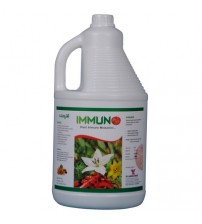
-202x224.jpg)
-202x224.png)
-202x224.png)
-202x224.png)
-202x224.png)
-202x224.png)
-202x224.png)
-202x224.png)
-202x224.png)
-202x224.png)
-202x224.png)
-202x224.png)
-202x224.png)
-202x224.png)
-202x224.png)
-202x224.png)
-202x224.png)
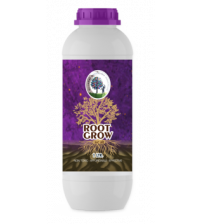
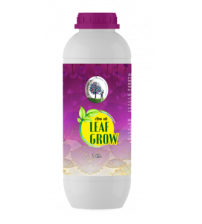
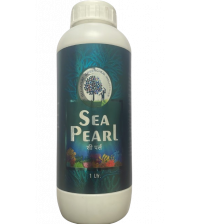
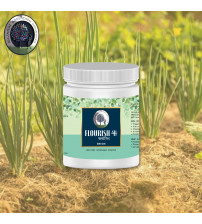

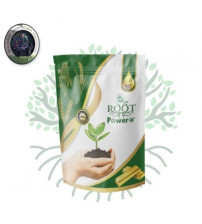
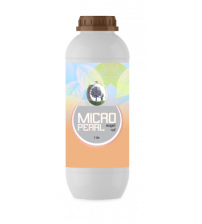

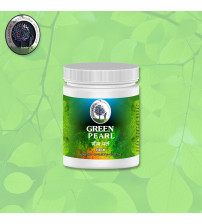
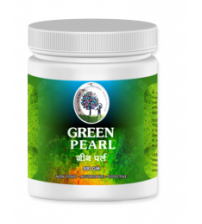
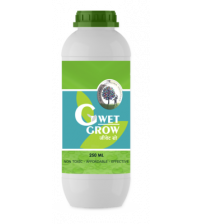
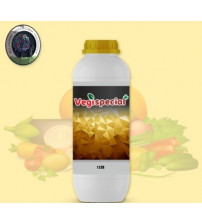
-202x224.jpg)
